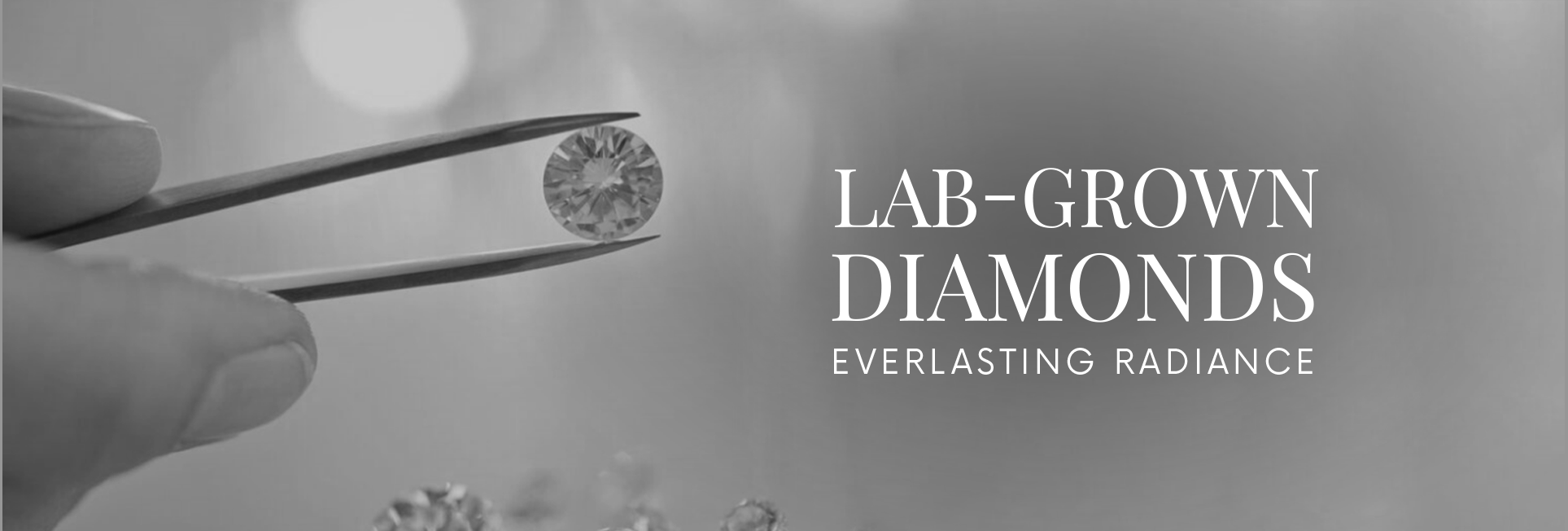Your cart is currently empty!

Benefits of Lab-Grown Diamonds
Lab-Grown diamonds possess the same characteristics as that earth-mined diamonds In fact, some lab-grown diamonds have less strain in their crystal structure and fewer defects than natural diamonds. Furthermore, they are purer than mined diamonds, which frequently contain dirt.
Here’s why going lab-grown is the smart, & conscious choice for you:
You are aware of
the origin
of your diamond.
You get a larger
diamond for
your money.
Fancy-colored
diamonds are
within your
financial means.
Lab-grown
diamonds are
eco-friendly.

Prominent Shapes of Our Lab-Grown Diamonds:

Round Brilliant
Our most popular cut, the round brilliant is a true masterpiece. Its 58 facets work in perfect harmony, unleashing a dazzling cascade of sparkle that mesmerizes from every angle.

Oval
Our most popular cut, the round brilliant is a true masterpiece. Its 58 facets work in perfect harmony, unleashing a dazzling cascade of sparkle that mesmerizes from
every angle.

Pear
A symbol of love and personal style, the pear cut echoes the teardrop shape with its pointed tip and gracefully curved base. This unique form flatters various finger shapes, adding a touch of sophistication that complements any outfit.

Cushion
Embrace a touch of vintage charm with a modern twist. The cushion cut features soft, rounded corners and a slightly elongated shape. Its gentle lines exude warmth and elegance, creating a captivating sparkle that flatters any occasion..

Princess
Embrace a bold and confident style with the princess cut. This striking square boasts sharp corners and a captivating geometric brilliance. Its clean lines make it a perfect statement piece for those who appreciate modern sophistication.

Radiant
A mesmerizing fusion of fire and geometric beauty, the radiant cut combines the beauty of an emerald cut with the brilliant faceting of a round diamond. This captivating shape delivers a play of light that is both mesmerizing and unforgettable.

Emerald
Experience classic beauty with the emerald cut. This rectangular shape features elongated facets and cropped corners, highlighting the diamond’s natural brilliance. This classic cut is perfect for those who appreciate a subtle yet sophisticated statement piece.
Understanding the 4Cs of Lab-Grown Diamonds
At The Jewel House, we believe knowledge empowers you to find the perfect diamond.
Embrace the privilege of choosing the finest lab-grown diamond with our guide to the 4Cs:
1. Cut
The first C, referring to Cut, is the craftsmanship that brings a diamond into shape and proportion. It’s through this careful construction that a diamond’s brilliance and fire are released. If a lab-grown diamond is well constructed, it has no other choice but to bring out the light return that can leave one breathless in its play of sparkle and light. If it’s the sparkle you’re looking for, the round brilliant will give that exceptional splendour; however, there are many other beautiful shapes: the captivating oval, the romantic pear, or the radiant geometrical. No matter what shape you decide on, a masterfully cut diamond will be capable of giving off its radiance to the fullest.

2. Clarity
The second C, clarity, delves into the diamond’s inner world. Natural microscopic birthmarks, called blemishes and inclusions, can be present within or on the diamond. The fewer these imperfections,the higher the clarity grade and generally the higher the value.Remember, absolute perfection is exceptionally rare. However,slight inclusions have minimal impact on the diamond’s overall beauty.

3. Colour
Diamonds are colourless; however, due to the presence of trace elements, a hint of colour may arise. Colourless diamonds are the most valuable and rare; however, fancy-coloured diamonds, such as those with a pink or blue hue,can be very valuable depending on the intensity and shade of colour. The Gemological Institute of America grades diamonds forcolour using a D-to-Z colour scale based on hue, tone, and saturation. D signifies a nearly colourless diamond, while Z has a prominent yellow tint.

4. Carat
The final C, carat, represents the unit of measurement specific to diamonds and gemstones. Carat weight signifies the diamond’s mass, not its physical size. This can be surprising, as different shapes can appear larger or smaller at the same carat weight due to variations in density and cut. For example, an oval diamond might appear more prominentthan a round brilliant diamond of the same carat weight. When considering pieces with multiple diamonds, the total carat weight (TCW) refers tothe combined weight of all the diamonds in the piece.



